Abstract
DNA was extracted from approximately 600-year-old human remains found at an archaeological site in the southwestern United States, and mtDNA fragments were amplified by PCR. When these fragments were sequenced directly, multiple sequences seemed to be present. From three representative individuals, DNA fragments of different lengths were quantified and short overlapping amplification products cloned. When amplifications started from <40 molecules, clones contained several different sequences. In contrast, when they were initiated by a few thousand molecules, unambiguous and reproducible results were achieved. These results show that more experimental work than is often applied is necessary to ensure that DNA sequences amplified from ancient human remains are authentic. In particular, quantitation of the numbers of amplifiable molecules is a useful tool to determine the role of contaminating contemporary molecules and PCR errors in amplifications from ancient DNA.
Full text
PDF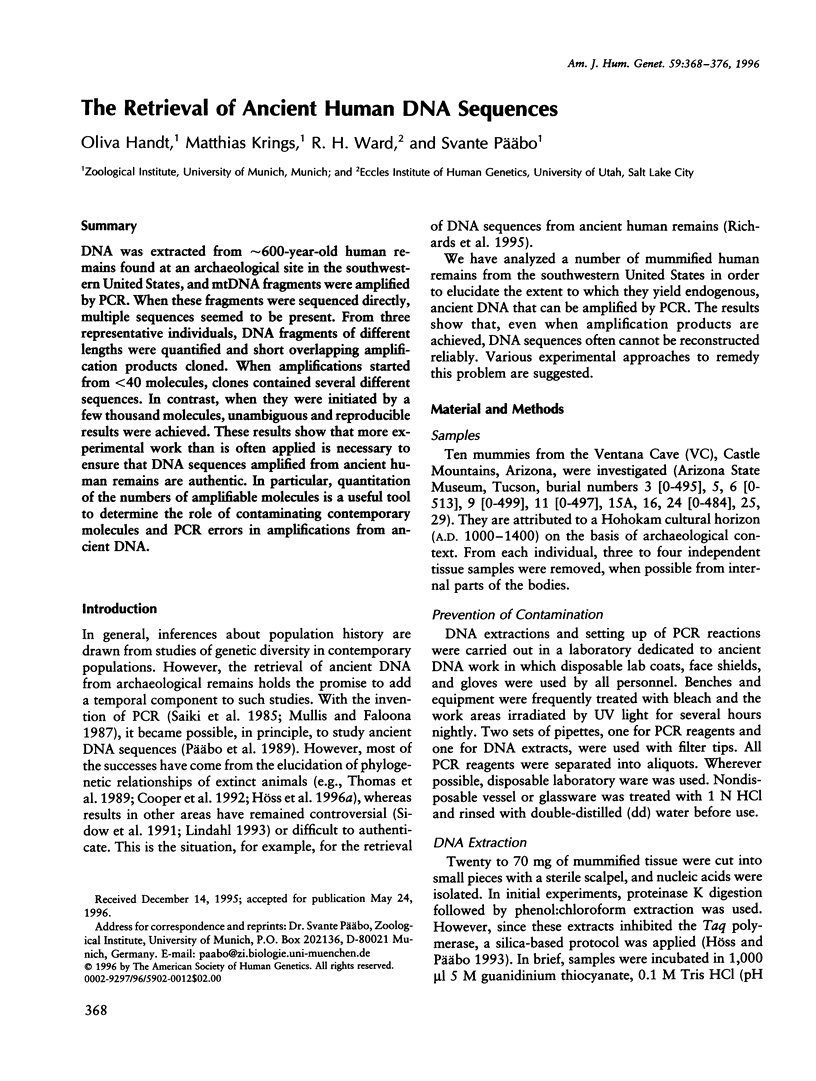
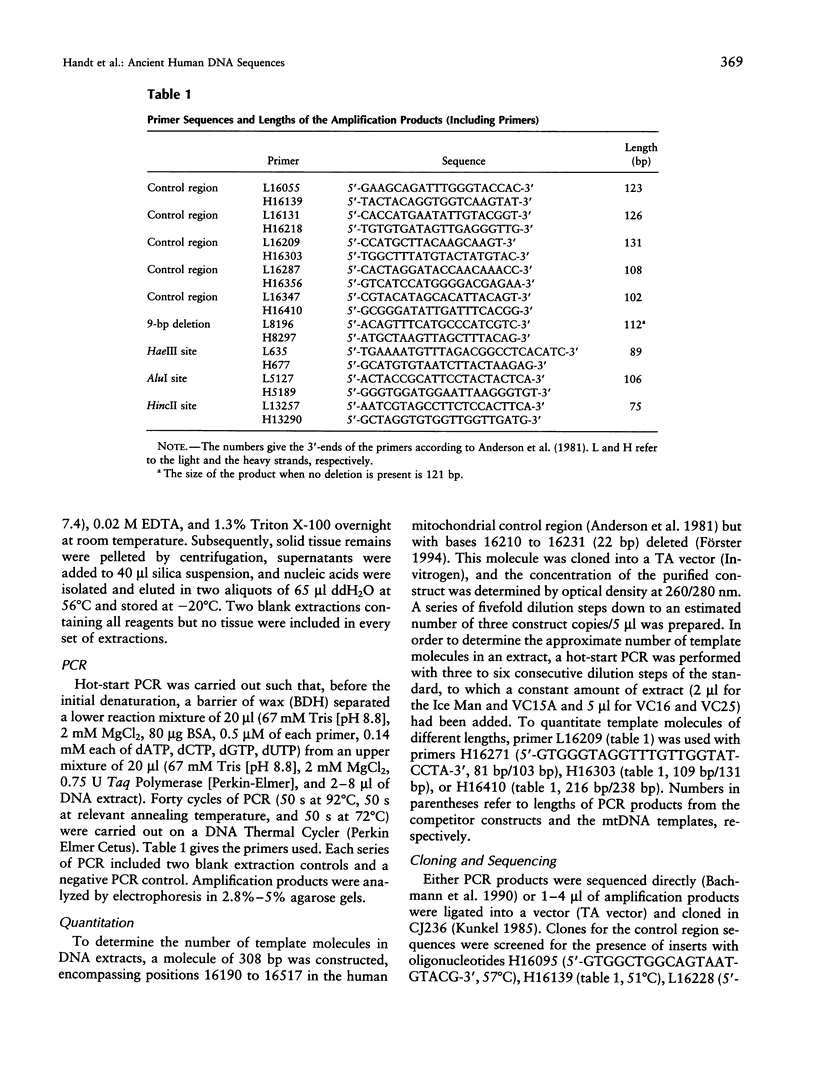
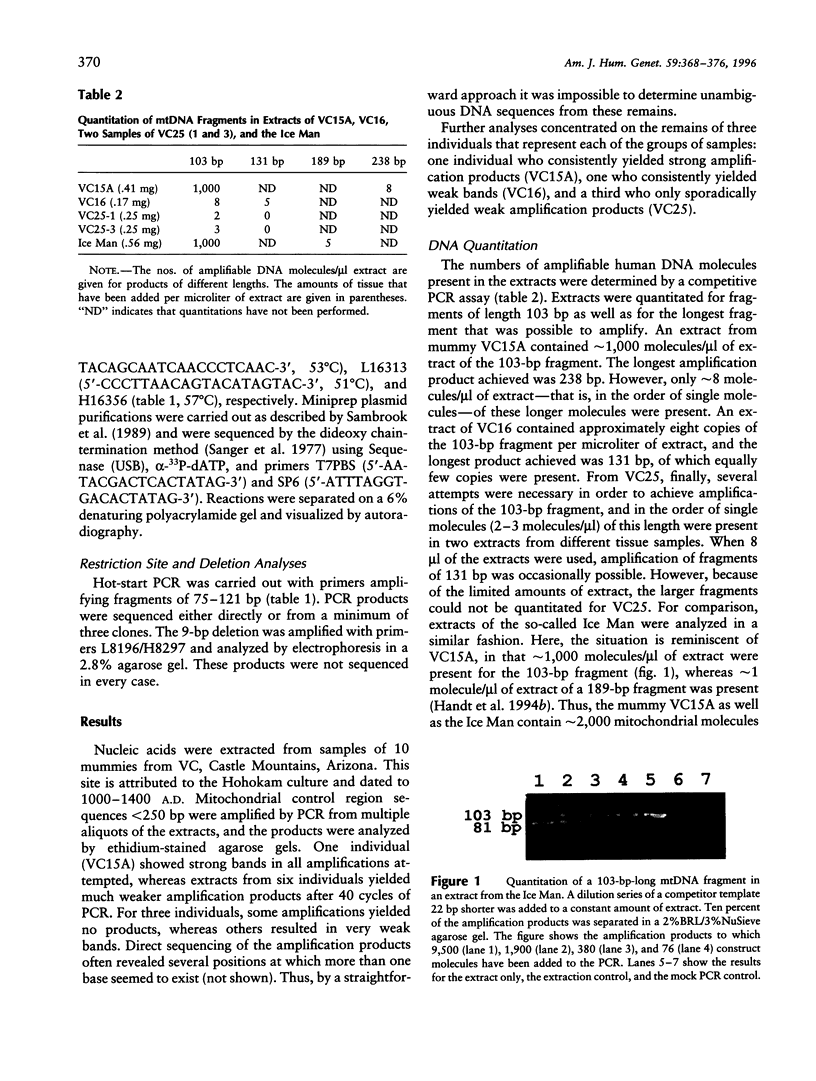
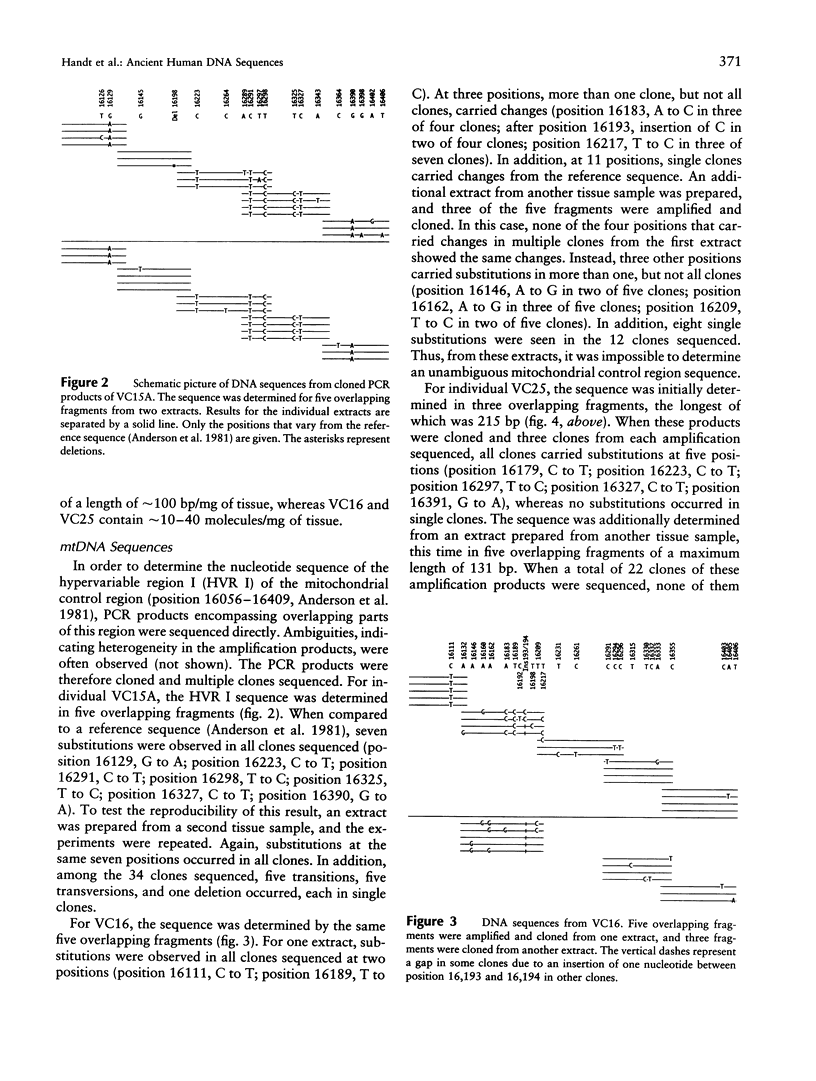
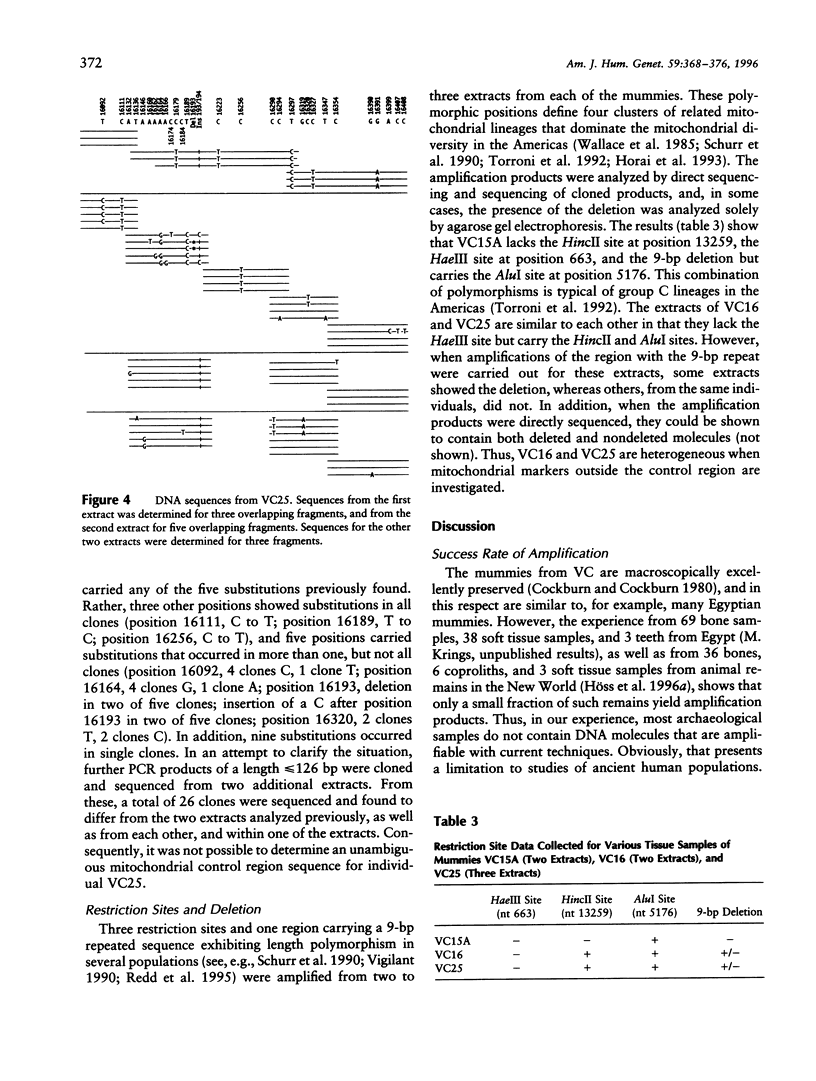
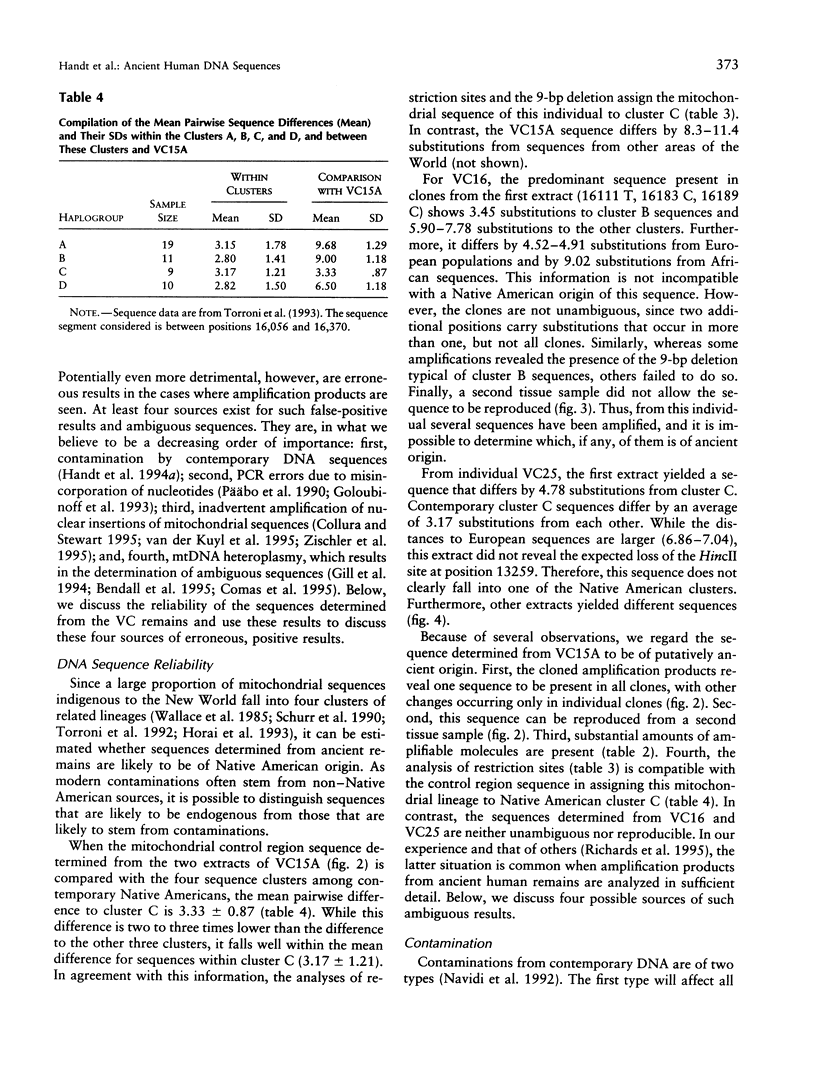
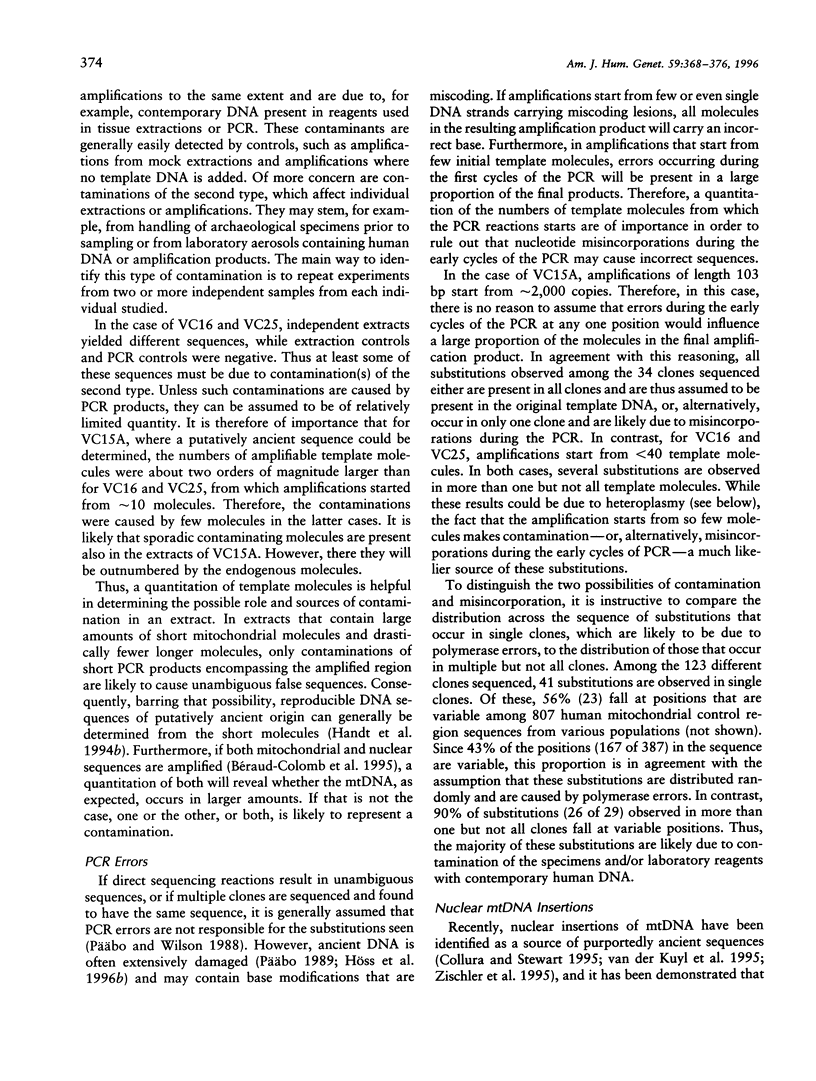
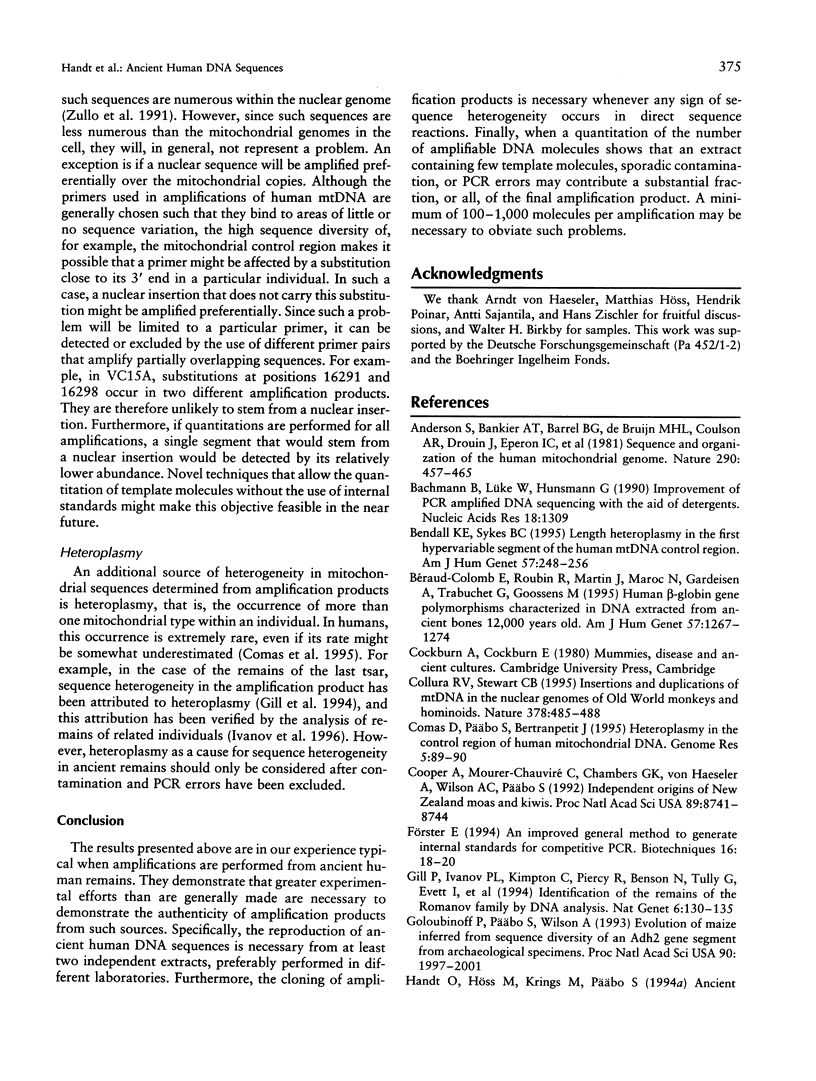

Images in this article
Selected References
These references are in PubMed. This may not be the complete list of references from this article.
- Anderson S., Bankier A. T., Barrell B. G., de Bruijn M. H., Coulson A. R., Drouin J., Eperon I. C., Nierlich D. P., Roe B. A., Sanger F. Sequence and organization of the human mitochondrial genome. Nature. 1981 Apr 9;290(5806):457–465. doi: 10.1038/290457a0. [DOI] [PubMed] [Google Scholar]
- Bachmann B., Lüke W., Hunsmann G. Improvement of PCR amplified DNA sequencing with the aid of detergents. Nucleic Acids Res. 1990 Mar 11;18(5):1309–1309. doi: 10.1093/nar/18.5.1309. [DOI] [PMC free article] [PubMed] [Google Scholar]
- Bendall K. E., Sykes B. C. Length heteroplasmy in the first hypervariable segment of the human mtDNA control region. Am J Hum Genet. 1995 Aug;57(2):248–256. [PMC free article] [PubMed] [Google Scholar]
- Béraud-Colomb E., Roubin R., Martin J., Maroc N., Gardeisen A., Trabuchet G., Goosséns M. Human beta-globin gene polymorphisms characterized in DNA extracted from ancient bones 12,000 years old. Am J Hum Genet. 1995 Dec;57(6):1267–1274. [PMC free article] [PubMed] [Google Scholar]
- Comas D., Päbo S., Bertranpetit J. Heteroplasmy in the control region of human mitochondrial DNA. Genome Res. 1995 Aug;5(1):89–90. doi: 10.1101/gr.5.1.89. [DOI] [PubMed] [Google Scholar]
- Cooper A., Mourer-Chauviré C., Chambers G. K., von Haeseler A., Wilson A. C., Päbo S. Independent origins of New Zealand moas and kiwis. Proc Natl Acad Sci U S A. 1992 Sep 15;89(18):8741–8744. doi: 10.1073/pnas.89.18.8741. [DOI] [PMC free article] [PubMed] [Google Scholar]
- Förster E. An improved general method to generate internal standards for competitive PCR. Biotechniques. 1994 Jan;16(1):18–20. [PubMed] [Google Scholar]
- Gill P., Ivanov P. L., Kimpton C., Piercy R., Benson N., Tully G., Evett I., Hagelberg E., Sullivan K. Identification of the remains of the Romanov family by DNA analysis. Nat Genet. 1994 Feb;6(2):130–135. doi: 10.1038/ng0294-130. [DOI] [PubMed] [Google Scholar]
- Goloubinoff P., Päbo S., Wilson A. C. Evolution of maize inferred from sequence diversity of an Adh2 gene segment from archaeological specimens. Proc Natl Acad Sci U S A. 1993 Mar 1;90(5):1997–2001. doi: 10.1073/pnas.90.5.1997. [DOI] [PMC free article] [PubMed] [Google Scholar]
- Handt O., Richards M., Trommsdorff M., Kilger C., Simanainen J., Georgiev O., Bauer K., Stone A., Hedges R., Schaffner W. Molecular genetic analyses of the Tyrolean Ice Man. Science. 1994 Jun 17;264(5166):1775–1778. doi: 10.1126/science.8209259. [DOI] [PubMed] [Google Scholar]
- Horai S., Kondo R., Nakagawa-Hattori Y., Hayashi S., Sonoda S., Tajima K. Peopling of the Americas, founded by four major lineages of mitochondrial DNA. Mol Biol Evol. 1993 Jan;10(1):23–47. doi: 10.1093/oxfordjournals.molbev.a039987. [DOI] [PubMed] [Google Scholar]
- Höss M., Dilling A., Currant A., Päbo S. Molecular phylogeny of the extinct ground sloth Mylodon darwinii. Proc Natl Acad Sci U S A. 1996 Jan 9;93(1):181–185. doi: 10.1073/pnas.93.1.181. [DOI] [PMC free article] [PubMed] [Google Scholar]
- Höss M., Jaruga P., Zastawny T. H., Dizdaroglu M., Päbo S. DNA damage and DNA sequence retrieval from ancient tissues. Nucleic Acids Res. 1996 Apr 1;24(7):1304–1307. doi: 10.1093/nar/24.7.1304. [DOI] [PMC free article] [PubMed] [Google Scholar]
- Höss M., Päbo S. DNA extraction from Pleistocene bones by a silica-based purification method. Nucleic Acids Res. 1993 Aug 11;21(16):3913–3914. doi: 10.1093/nar/21.16.3913. [DOI] [PMC free article] [PubMed] [Google Scholar]
- Ivanov P. L., Wadhams M. J., Roby R. K., Holland M. M., Weedn V. W., Parsons T. J. Mitochondrial DNA sequence heteroplasmy in the Grand Duke of Russia Georgij Romanov establishes the authenticity of the remains of Tsar Nicholas II. Nat Genet. 1996 Apr;12(4):417–420. doi: 10.1038/ng0496-417. [DOI] [PubMed] [Google Scholar]
- Kunkel T. A. Rapid and efficient site-specific mutagenesis without phenotypic selection. Proc Natl Acad Sci U S A. 1985 Jan;82(2):488–492. doi: 10.1073/pnas.82.2.488. [DOI] [PMC free article] [PubMed] [Google Scholar]
- Lindahl T. Recovery of antediluvian DNA. Nature. 1993 Oct 21;365(6448):700–700. doi: 10.1038/365700a0. [DOI] [PubMed] [Google Scholar]
- Mullis K. B., Faloona F. A. Specific synthesis of DNA in vitro via a polymerase-catalyzed chain reaction. Methods Enzymol. 1987;155:335–350. doi: 10.1016/0076-6879(87)55023-6. [DOI] [PubMed] [Google Scholar]
- Navidi W., Arnheim N., Waterman M. S. A multiple-tubes approach for accurate genotyping of very small DNA samples by using PCR: statistical considerations. Am J Hum Genet. 1992 Feb;50(2):347–359. [PMC free article] [PubMed] [Google Scholar]
- Päbo S. Ancient DNA: extraction, characterization, molecular cloning, and enzymatic amplification. Proc Natl Acad Sci U S A. 1989 Mar;86(6):1939–1943. doi: 10.1073/pnas.86.6.1939. [DOI] [PMC free article] [PubMed] [Google Scholar]
- Päbo S., Higuchi R. G., Wilson A. C. Ancient DNA and the polymerase chain reaction. The emerging field of molecular archaeology. J Biol Chem. 1989 Jun 15;264(17):9709–9712. [PubMed] [Google Scholar]
- Päbo S., Irwin D. M., Wilson A. C. DNA damage promotes jumping between templates during enzymatic amplification. J Biol Chem. 1990 Mar 15;265(8):4718–4721. [PubMed] [Google Scholar]
- Päbo S., Wilson A. C. Polymerase chain reaction reveals cloning artefacts. Nature. 1988 Aug 4;334(6181):387–388. doi: 10.1038/334387b0. [DOI] [PubMed] [Google Scholar]
- Redd A. J., Takezaki N., Sherry S. T., McGarvey S. T., Sofro A. S., Stoneking M. Evolutionary history of the COII/tRNALys intergenic 9 base pair deletion in human mitochondrial DNAs from the Pacific. Mol Biol Evol. 1995 Jul;12(4):604–615. doi: 10.1093/oxfordjournals.molbev.a040240. [DOI] [PubMed] [Google Scholar]
- Saiki R. K., Scharf S., Faloona F., Mullis K. B., Horn G. T., Erlich H. A., Arnheim N. Enzymatic amplification of beta-globin genomic sequences and restriction site analysis for diagnosis of sickle cell anemia. Science. 1985 Dec 20;230(4732):1350–1354. doi: 10.1126/science.2999980. [DOI] [PubMed] [Google Scholar]
- Sanger F., Nicklen S., Coulson A. R. DNA sequencing with chain-terminating inhibitors. Proc Natl Acad Sci U S A. 1977 Dec;74(12):5463–5467. doi: 10.1073/pnas.74.12.5463. [DOI] [PMC free article] [PubMed] [Google Scholar]
- Schurr T. G., Ballinger S. W., Gan Y. Y., Hodge J. A., Merriwether D. A., Lawrence D. N., Knowler W. C., Weiss K. M., Wallace D. C. Amerindian mitochondrial DNAs have rare Asian mutations at high frequencies, suggesting they derived from four primary maternal lineages. Am J Hum Genet. 1990 Mar;46(3):613–623. [PMC free article] [PubMed] [Google Scholar]
- Sidow A., Wilson A. C., Päbo S. Bacterial DNA in Clarkia fossils. Philos Trans R Soc Lond B Biol Sci. 1991 Sep 30;333(1268):429–433. doi: 10.1098/rstb.1991.0093. [DOI] [PubMed] [Google Scholar]
- Thomas R. H., Schaffner W., Wilson A. C., Päbo S. DNA phylogeny of the extinct marsupial wolf. Nature. 1989 Aug 10;340(6233):465–467. doi: 10.1038/340465a0. [DOI] [PubMed] [Google Scholar]
- Torroni A., Schurr T. G., Yang C. C., Szathmary E. J., Williams R. C., Schanfield M. S., Troup G. A., Knowler W. C., Lawrence D. N., Weiss K. M. Native American mitochondrial DNA analysis indicates that the Amerind and the Nadene populations were founded by two independent migrations. Genetics. 1992 Jan;130(1):153–162. doi: 10.1093/genetics/130.1.153. [DOI] [PMC free article] [PubMed] [Google Scholar]
- Torroni A., Sukernik R. I., Schurr T. G., Starikorskaya Y. B., Cabell M. F., Crawford M. H., Comuzzie A. G., Wallace D. C. mtDNA variation of aboriginal Siberians reveals distinct genetic affinities with Native Americans. Am J Hum Genet. 1993 Sep;53(3):591–608. [PMC free article] [PubMed] [Google Scholar]
- Zischler H., Höss M., Handt O., von Haeseler A., van der Kuyl A. C., Goudsmit J. Detecting dinosaur DNA. Science. 1995 May 26;268(5214):1192–1194. doi: 10.1126/science.7605504. [DOI] [PubMed] [Google Scholar]
- Zullo S., Sieu L. C., Slightom J. L., Hadler H. I., Eisenstadt J. M. Mitochondrial D-loop sequences are integrated in the rat nuclear genome. J Mol Biol. 1991 Oct 20;221(4):1223–1235. [PubMed] [Google Scholar]
- van der Kuyl A. C., Kuiken C. L., Dekker J. T., Perizonius W. R., Goudsmit J. Nuclear counterparts of the cytoplasmic mitochondrial 12S rRNA gene: a problem of ancient DNA and molecular phylogenies. J Mol Evol. 1995 Jun;40(6):652–657. doi: 10.1007/BF00160513. [DOI] [PubMed] [Google Scholar]



